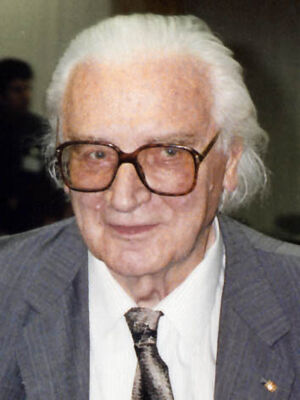Konrad Zuse (nonfiction)
Konrad Zuse (German: [ˈkɔnʁat ˈtsuːzə]; 22 June 1910 – 18 December 1995) was a German civil engineer, inventor and computer pioneer. His greatest achievement was the world's first programmable computer; the functional program-controlled Turing-complete Z3 became operational in May 1941. Thanks to this machine and its predecessors, Zuse has often been regarded as the inventor of the modern computer.
Born in Berlin, Germany, on 22 June 1910, he moved with his family in 1912 to East Prussian Braunsberg (now Braniewo in Poland), where his father was a postal clerk. Zuse attended the Collegium Hosianum in Braunsberg. In 1923, the family moved to Hoyerswerda, where he passed his Abitur in 1928, qualifying him to enter university.
He enrolled in the Technische Hochschule Berlin (now Technical University of Berlin) and explored both engineering and architecture, but found them boring. Zuse then pursued civil engineering, graduating in 1935. For a time, he worked for the Ford Motor Company, using his considerable artistic skills in the design of advertisements. He started work as a design engineer at the Henschel aircraft factory in Schönefeld near Berlin. This required the performance of many routine calculations by hand, which he found mind-numbingly boring, leading him to dream of doing them by machine.
Zuse completed his work entirely independently of other leading computer scientists and mathematicians of his day. Between 1936 and 1945, he was in near-total intellectual isolation.
In 1939, Zuse was called to military service, where he was given the resources to ultimately build the Z2.
Beginning in 1935 he experimented in the construction of computers in his parents' flat on Wrangelstraße 38, moving with them into their new flat on Methfesselstraße 10, the street leading up the Kreuzberg, Berlin. Working in his parents' apartment in 1936, he produced his first attempt, the Z1, a floating point binary mechanical calculator with limited programmability, reading instructions from a perforated 35 mm film. In 1937, Zuse submitted two patents that anticipated a von Neumann architecture. He finished the Z1 in 1938. The Z1 contained some 30,000 metal parts and never worked well due to insufficient mechanical precision.
Much of his early work was financed by his family and commerce, but after 1939 he was given resources by the Nazi German government. Due to World War II, Zuse's work went largely unnoticed in the United Kingdom and the United States.
In September 1940 Zuse presented the Z2, covering several rooms in the parental flat, to experts of the Deutsche Versuchsanstalt für Luftfahrt (DVL; i.e. German Research Institute for Aviation). The Z2 was a revised version of the Z1 using telephone relays.
Improving on the basic Z2 machine, he built the Z3 in 1941. On 12 May 1941 Zuse presented the Z3, built in his workshop, to the public. The Z3 was a binary 22-bit floating point calculator featuring programmability with loops but without conditional jumps, with memory and a calculation unit, based on telephone relays. Despite the absence of conditional jumps, the Z3 was a Turing complete computer, although Zuse never considered Turing-completeness, having practical applications in mind.
The DVL granted research subsidies so that in 1941 Zuse started one of the first computer companies, Zuse Apparatebau (Zuse Apparatus Construction), to manufacture his machines.
Zuse's workshop on Methfesselstraße 7 (with the Z3) was destroyed in an Allied Air raid in late 1943.
From 1943 to 1945 he designed the first high-level programming language, Plankalkül.
On 30 January 1944, the Z1 and its original blueprints were destroyed with his parents' flat and many neighbouring buildings by a British air raid in World War II. This event effectively brought Zuse's research and development to a complete halt. The partially finished, relay-based Z4 was packed and moved from Berlin on 14 February, only arriving in Göttingen two weeks later.
Possibly his first documented influence on a US company was IBM's option on his patents in 1946.
Work on the Z4 could not be resumed immediately in the extreme privation of post-war Germany, and it was not until 1949 that he was able to resume work on it. He showed it to the mathematician Eduard Stiefel of the Swiss Federal Institute of Technology Zurich (Eidgenössische Technische Hochschule (ETH) Zürich) who ordered one in 1950. On 8 November 1949, Zuse KG was founded. The Z4 was delivered to ETH Zurich on 12 July 1950, and proved very reliable.
In 1969, Zuse suggested the concept of a computation-based universe in his book Rechnender Raum (Calculating Space).
Between 1987 and 1989, Zuse recreated the Z1, suffering a heart attack midway through the project. It cost 800,000 DM, (approximately $500,000) and required four individuals (including Zuse) to assemble it. Funding for this retrocomputing project was provided by Siemens and a consortium of five companies.
In the News
Fiction cross-reference
Nonfiction cross-reference
External links:
- Konrad Zuse @ Wikipedia
Attribution:
